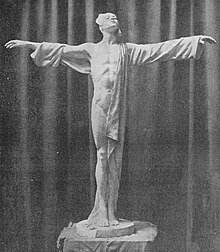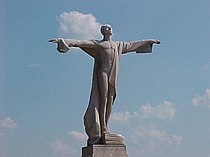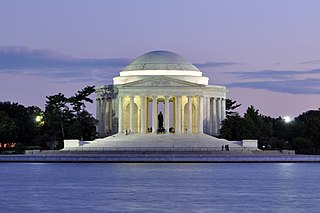
The Jefferson Memorial is a presidential memorial in Washington, D.C. It was built between 1939 and 1943 in honor of Thomas Jefferson, the principal author of the United States Declaration of Independence, a central intellectual force behind the American Revolution, a founder of the Democratic-Republican Party, and the nation's third president.
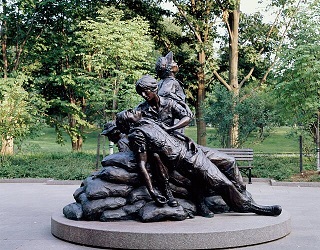
The Vietnam Women's Memorial is a memorial dedicated to the nurses and women of the United States who served in the Vietnam War. It depicts three uniformed women with a wounded male soldier to symbolize the support and caregiving roles that women played in the war as nurses and other specialists. It is part of the Vietnam Veterans Memorial and is located on the National Mall in Washington, D.C., a short distance south of the Wall and north of the Reflecting Pool. The statues are bronze and the base is made of granite. The United States Commission of Fine Arts and the National Capital Planning Commission selected Glenna Goodacre to sculpt the memorial after previously rejecting the idea for a memorial to women.
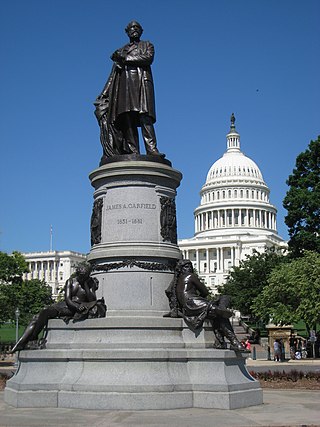
The James A. Garfield Monument stands on the grounds of the United States Capitol in the traffic circle at First Street and Maryland Avenue SW in Washington, D.C. It is a memorial to U.S. President James A. Garfield, who was elected in 1880 and assassinated in 1881 after serving only four months of his term. The perpetrator was an attorney and disgruntled office-seeker named Charles J. Guiteau. Garfield lived for several weeks after the shooting, but eventually succumbed to his injuries. The monument is part of a three-part sculptural group near the Capitol Reflecting Pool, including the Peace Monument and the Ulysses S. Grant Memorial in Union Square. The monument is also a contributing property to the National Mall and L'Enfant Plan, both of which are listed on the National Register of Historic Places and the District of Columbia Inventory of Historic Sites. The bronze statue rests on a granite pedestal that features three sculptures, each one representing a time period in Garfield's life.

The John Paul Jones Memorial, also known as Commodore John Paul Jones, is a monument in West Potomac Park, Washington, D.C. The memorial honors John Paul Jones, the United States' first naval war hero, and received the Congressional Gold Medal after the American Revolutionary War ended. Jones allegedly said "I have not yet begun to fight!" during the Battle of Flamborough Head.

The Taras Shevchenko Memorial is a bronze statue and stone relief-adorned wall located on the 2200 block of P Street NW in the Dupont Circle neighborhood of Washington, D.C., United States. It is one of many monuments in Washington, D.C. that honor foreign heroes who symbolize freedom in their native countries. Sculpted by Leo Mol, the memorial honors Taras Shevchenko (1814–1861), a Ukrainian poet and artist who influenced the development of modern Ukrainian literature.
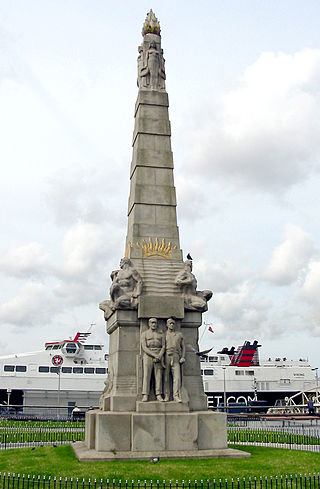
The Memorial to Heroes of the Marine Engine Room is a granite monument located on St. Nicholas Place, at the Pier Head, in Liverpool, England.

The Luther Monument is a public artwork located in front of Luther Place Memorial Church in Washington, D.C., United States. The monument to Martin Luther, the theologian and Protestant Reformer, is a bronze, full-length portrait. It is a copy of the statue created by Ernst Friedrich August Rietschel as part of the 1868 Luther Monument in Worms, Germany. The version in Washington, D.C., inspired the installation of many other castings across the U.S. The statue is a contributing property to the Luther Place Memorial Church's listing on the National Register of Historic Places (NRHP) and District of Columbia Inventory of Historic Sites (DCIHS). It is also a contributing property to the Greater Fourteenth Street Historic District, which is also listed on the NRHP and DCIHS.

Lieutenant General George Washington is an 1860 equestrian statue of George Washington, at Washington Circle, at the edge of the George Washington University's campus, in Washington, D.C. The statue was sculpted by Clark Mills, who also created the equestrian statue of Andrew Jackson in front of the White House. The traffic circle where the statue is located was one of the original city designs by Pierre Charles L'Enfant. The statue and surrounding park are in the Foggy Bottom neighborhood at the intersection of 23rd Street, New Hampshire Avenue, and Pennsylvania Avenue NW. The K Street NW underpass runs beneath the circle.
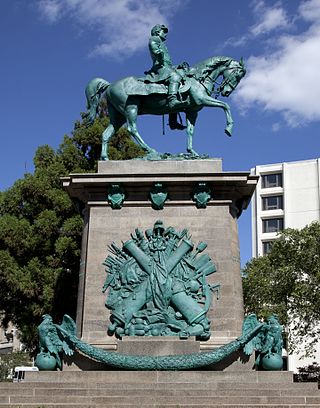
Major General George B. McClellan is an equestrian statue in Washington, D.C. that honors politician and Civil War general George B. McClellan. The monument is sited on a prominent location in the Kalorama Triangle neighborhood due to efforts made by area residents. The statue was sculpted by American artist Frederick William MacMonnies, a graduate of the École des Beaux-Arts whose best known work is a statue of Nathan Hale in New York City. MacMonnies was chosen to design the statue following a lengthy competition organized by a statue commission, led by then Secretary of War William Howard Taft. The monument was dedicated in 1907, with prominent attendees at the ceremony including President Theodore Roosevelt, New York City mayor George B. McClellan Jr., politicians, generals and thousands of military personnel.

Major General George Henry Thomas, also known as the Thomas Circle Monument, is an equestrian sculpture in Washington, D.C. that honors Civil War general George Henry Thomas. The monument is located in the center of Thomas Circle, on the border of the downtown and Logan Circle neighborhoods. It was sculpted by John Quincy Adams Ward, best known for his work on the statue of George Washington in Wall Street, Manhattan. Attendees at the dedication in 1879 included President Rutherford B. Hayes, Generals Irvin McDowell, Philip Sheridan, and William Tecumseh Sherman, senators and thousands of soldiers.
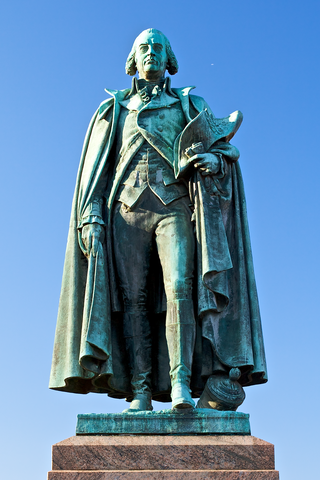
General Artemas Ward is a bronze statue of American Revolutionary War general Artemas Ward. It is sited in the center of Ward Circle, which was specifically made for the statue, at the intersection of Nebraska and Massachusetts Avenue in the American University Park neighborhood of Washington, D.C. The 10-foot (3.0 m) statue of Ward was completed in 1936, but was not unveiled for two years. Ward was the first Commander-in-Chief of colonial forces during the Revolutionary War and served in a number of government roles, including as representative to the United States House of Representatives.

Brigadier General Thaddeus Kościuszko is a bronze statue honoring Polish military figure and engineer Tadeusz Kościuszko. The sculpture was dedicated in 1910, the third of four statues in Lafayette Square, Washington, D.C., to honor foreign-born heroes of the American Revolutionary War. Born in the Polish–Lithuanian Commonwealth in 1746, Kościuszko later received education at a Jesuit school before attending the Corps of Cadets in Warsaw. He later traveled to France where he studied in military academy libraries and adopted views of human liberty during the Age of Enlightenment. He moved to the Thirteen Colonies in 1776, where the war with the Kingdom of Great Britain had already begun. Kościuszko served as an engineer in the Continental Army, earning the praise of his superiors, including General George Washington.

Bishop John Carroll is a statue by the sculptor Jerome Connor commemorating Archbishop John Carroll, the founder of Georgetown University and the first Catholic bishop in the United States. Located in front of Healy Hall, on university's campus in the Georgetown neighborhood of Washington, D.C., the statue consists of a bronze sculpture of Carroll on top of a granite pedestal.

The statue of John Barry commemorates the "Father of the United States Navy", Commodore John Barry (1745-1806). Barry was an Irish-born sailor who joined the American colonists in fighting for independence from the Kingdom of Great Britain. Barry became the first commission by the Second Continental Congress. He captained several ships during the war, and not only fought in the Continental Navy, but also the Continental Army. He was the first American to capture an enemy ship and was promoted to commodore by President George Washington in 1794. Barry's last ship, the United States, fought in the Quasi-War. He retired in 1801, but remained head of the United States Navy until his death in 1806.

The outdoor statue of Benjamin Franklin in Washington, D.C., is located near the intersection of 12th Street and Pennsylvania Avenue, in front of the Old Post Office. The statue was a gift from Stilson Hutchins, founder of The Washington Post, who wanted to display his and the newspaper's stature in the city. The designer, Ernst Plassmann, and sculptor, Jacques Jouvenal, were both German-American artists. The architect of the memorial was J. F. Manning.

The Samuel Gompers Memorial is a bronze collection of statues in Washington, D.C., sited on a triangular park at the intersection of 11th Street, Massachusetts Avenue, and N Street NW. Gompers was an English-born American who grew up working in cigar factories, where he witnessed the long hours and dangerous conditions people experienced in factory jobs. He helped with growing the Cigar Makers' International Union, and a few years later, founded the American Federation of Labor (AFL). The number of members rose from 50,000 to 3,000,000 during his time as president of the union. He was not only successful in expanding the power of the labor movement, but also increased its prestige.

Memorials and monuments to victims of the sinking of the RMS Titanic exist in a number of places around the world associated with Titanic, notably in Belfast, Liverpool and Southampton in the United Kingdom; Halifax, Nova Scotia in Canada; and New York City and Washington, D.C. in the United States. The largest single contingent of victims came from Southampton, the home of most of the crew, which consequently has the greatest number of memorials. Titanic was built in Belfast, Northern Ireland, and had a "guarantee party" of engineers from shipbuilders Harland and Wolff aboard all of whom were lost in the disaster and are commemorated by a prominent memorial in the city. Other contingents of engineers aboard the ship came from the maritime cities of Liverpool in England and Glasgow in Scotland, which erected their own memorials. Several prominent victims, such as Titanic's captain, were commemorated individually. Elsewhere, in the United States and Australia, public memorials were erected to commemorate all the victims.
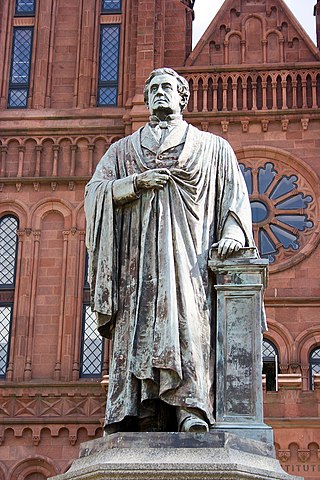
Professor Joseph Henry, also known as the Joseph Henry Memorial, is an outdoor bronze sculpture depicting scientist Joseph Henry, the first president of the Smithsonian Institution. The statue stands in front of the Smithsonian Institution Building in Washington, D.C., facing the National Mall. It was sculpted by artist William Wetmore Story, and dedicated in 1883, a few years after Henry's death. The bronze statue and granite base were unveiled in front of thousands of onlookers and invited guests. Speeches at the dedication included one from Chief Justice of the Supreme Court Morrison Waite, and the president of Yale College, Noah Porter.

The Arts of War and The Arts of Peace are bronze, fire-gilded statue groups on Lincoln Memorial Circle in West Potomac Park in Washington, D.C., in the United States. Commissioned in 1929 to complement the plaza constructed on the east side of the Lincoln Memorial as part of the Arlington Memorial Bridge approaches, their completion was delayed until 1939 for budgetary reasons. The models were placed into storage, and the statues not cast until 1950. They were erected in 1951, and repaired in 1974.
Lincoln Memorial at Waterfront Park is a statue of Abraham Lincoln, depicted as he would have looked before he became President of the United States. The sculpture of him is bareheaded, seated on a rock with an open law book in one hand and the other in an outstretched, welcoming gesture. The statue is located at Waterfront Park in Louisville, Kentucky. The Lincoln Memorial in Louisville is part of the Lincoln Heritage Trail. The statue and its accompanying bas-relief historical panels were created by American sculptor Ed Hamilton. Landscape design for Waterfront Park was by Hargreaves Associates. The 2006 Kentucky General Assembly authorized $2 million for the memorial, which was supplemented by private donations.


